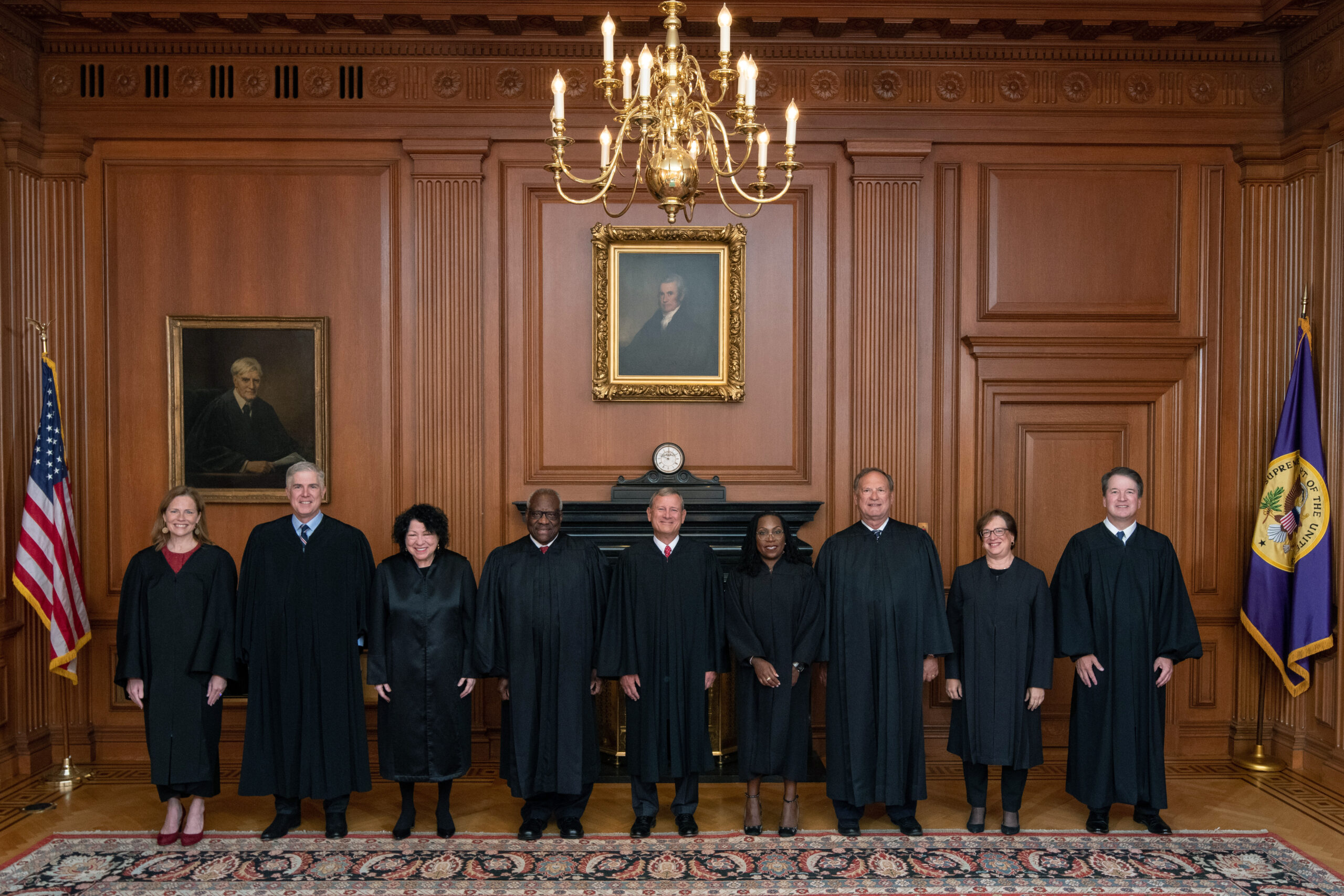Coke claimed the common law was the perfection of reason. Our Supreme Court began its recent opinion in State v. Phillips, No. 281A23 (N.C. Aug. 23, 2024), by citing Coke, albeit for a different proposition (i.e., a person’s home is his castle). Construing G.S. 14-51.2, our Supreme Court held that the legislature has abrogated the common law rule that prohibited excessive force in defense of the home. The trial court erred therefore in instructing the jury that the defendant homeowner did not have the right to use excessive force. This post examines the recent opinion in Phillips.
The Phillips Scenario
The facts in Phillips were contested. In April 2021, the victim approached the defendant’s home angry with a grievance (and possibly intoxicated), entered the front porch, and knocked on the door. The defendant answered and a brief confrontation followed, during which the defendant struck the victim (possibly with a gun). The defendant then fired multiple shots at the victim, one shot striking the victim’s left side, leaving her permanently disabled. Phillips, Slip Op. at 2.
The defendant was charged with assault with a deadly weapon with intent to kill inflicting serious injury. At trial, the defendant asserted self-defense and defense of habitation. Over objection, the trial court instructed the jury that the defendant did not have the right to use excessive force in defense of the home. The defendant was convicted of assault with a deadly weapon inflicting serious injury and appealed, arguing error in the instruction. Phillips, Slip Op. at 2-5.
Common Law and Statute
Our defensive force statutes date from 2011. As their placement in Chapter 14, Article 14 (Burglary) suggests, they can be traced to the common law privilege to use force to prevent a house breaking. Under the common law, a homeowner was permitted to use deadly force to prevent an unlawful entry if he reasonably believed an intruder intended to commit a felony or inflict serious injury upon the occupants. See State v. Miller, 267 N.C. 409, 411 (1966). By contrast, the privilege to use deadly force in self-defense required a person to have a reasonable belief such force was necessary to prevent death or great bodily harm. See State v. Richardson, 341 N.C. 585, 590 (1995).
By statute, a person is justified in the use of deadly force if: (1) he reasonably believes such force is necessary to prevent death or great bodily harm, or (2) “under the circumstances permitted pursuant to G.S. 14-51.2.” G.S. 14-51.3. Curiously, G.S. 14-51.2 does not explicitly permit the use of force. Instead, that statute creates two presumptions. First, a homeowner, when using deadly force, “is presumed to have held a reasonable fear of imminent death or serious bodily harm” if an intruder was unlawfully and forcefully entering and the homeowner knew it. G.S. 14-51.2(b). This presumption is rebuttable and does not apply in several statutorily defined circumstances, such as when the victim was a lawful resident of the home, authorized to enter. G.S. 14-51.2(c). Second, a person who unlawfully and forcefully enters is presumed to be doing so with the intent to commit an unlawful act of force or violence. G.S. 14-51.2(d). A person who uses force “as permitted by this section” is justified in using such force and is immune from civil or criminal liability. G.S. 14-51.2(e). As my colleague John Rubin noted, G.S. 14-51.2 is a complex statute.
A presumption of reasonableness appears to be unique in our criminal statutes. The common law of self-defense employs both rules and standards. Rollin M. Perkins & Ronald N. Boyce, Criminal Law, 1116 (3rd ed. 1982). One rule of law is that deadly force is not privileged against nondeadly force. State v. Pearson, 288 N.C. 34, 40 (1975). The jury then uses the reasonable person standard to assess the propriety of the defendant’s conduct. Id. at 39. The role of excessive force is disputed. Some cases treated it as a manifestation of the proportionality rule and some as an application of the reasonable person standard. Compare State v. Richardson, 341 N.C. 585, 590 (1995) (when the assault on the defendant is insufficient to give rise to a reasonable apprehension of death or great bodily harm, the use of deadly force “is excessive force as a matter of law”); with State v. Norman, 324 N.C. 253, 265 (1989) (“The use of deadly force in self-defense to prevent harm other than death or great bodily harm is excessive as a matter of law.”). Prior to Phillips, it was thus unclear what component of the defense of habitation the statutory presumption of reasonableness was intended to address. Cf. State v. Walker, 286 N.C. App. 438, 448 (2022) (G.S. 14-51.2 creates “a rebuttable presumption that deadly force is reasonable”).
Subsequent Caselaw
Courts have labored to reconcile the new statutes with the prior common law rules.
In State v. Benner, 380 N.C. 621 (2022), the defendant (who was attacked in his home) argued the trial court erred by failing to instruct the jury that the defendant could stand his ground and repel force with force, regardless of the character of the assault. Id. at 630; cf. N.C.P.I. – Crim. 308.10. But the trial court had instructed the jury that the defendant had no duty to retreat in the home, and our Supreme Court found no material difference between a no-duty-to-retreat and a stand-your-ground instruction. Benner, 380 N.C. at 635. As for the qualifier, “regardless of the character of the assault,” it had no application where there was no prior suggestion that the nature of the assailant’s attack had any bearing on the defendant’s duty to retreat. Id. at 636. In any event, “the proportionality rule inherent in the requirement that the defendant not use excessive force continues to exist even in instances in which a defendant is entitled to stand his or her ground.” Id.
In State v. Copley, 386 N.C. 111 (2024), the defendant (who fired upon the victim from inside his home) argued the trial court erred by instructing the jury on lying-in-wait. Id. at 120. Under a theory of lying in wait, the defendant is guilty of first-degree murder – absent any showing of premeditation or deliberation – if the evidence shows the defendant stationed himself or lay in wait for a private attack upon the victim. See State v. Leroux, 326 N.C. 368, 375 (1990); cf. N.C.P.I. – Crim. 206.16. The defendant in Copley argued that the trial court’s instruction on lying-in-wait undermined his right to defend the home under G.S. 14-51.2. Our Supreme Court agreed in part.
The right to use force in defense of the home under G.S. 14-51.2, it said, “is not a license to kill.” Copley, 386 N.C. at 123. The State might rebut the presumption of reasonableness, and hence a homeowner’s right to use deadly force, by means identified in the statute – the victim was a lawful resident of the home, G.S. 14-51.2(c)(1); or the victim was a law enforcement officer performing official duties, G.S. 14-51.2(c)(4) – or otherwise – the victim was an authorized invitee, a Girl Scout, or a trick-or-treater. Id. But a defendant entitled to the statutory presumption of G.S. 14-51.2 cannot be convicted of murder by lying in wait because a homeowner defending his castle from invasion cannot be characterized as an assassin waiting to ambush his victim. Id. at 123-34.
Benner and Copley thus represent an accommodation of the common law to the new statutory scheme. Both recognized that the pattern jury instructions contain propositions derived from the common law and the new statutes. Cf. State v. Leaks, 270 N.C. App. 317, 324 (2020) (noting pattern instructions were revised “to harmonize” common law and 2011 statutes). Benner acknowledged a defendant’s statutory right to stand his ground, while it retained the common law requirement that a defendant not use excessive force, even in instances where he is entitled to stand his ground. Benner, 380 N.C. at 636 (“the proportionality rule”). Copley recognized that the privilege codified in G.S. 14-51.2 obviates in some circumstances the common law theory of lying in wait for first-degree murder, but it also construed the presumption created by G.S. 14-51.2(b) as rebuttable by both statutory and nonstatutory circumstances alike. Copley, 386 N.C. 111, 123; see also State v. Austin, 279 N.C. App. 377, 384 (2021) (G.S. 14-51.2’s “rebuttable presumption is not limited” to enumerated circumstances). As our Supreme Court noted elsewhere, the judicial difficulty is in determining whether the new defensive force statutes merely restate, moderately revise, or entirely abrogate common law rules. See State v. McLymore, 380 N.C. 185, 190 (2022).
State v. Phillips
The defendant in Phillips (who fired upon the victim from inside her home) was convicted of assault with a deadly weapon inflicting serious injury and appealed, arguing the trial court erred by instructing the jury that the defendant did not have the right to use excessive force in defense of habitation. Phillips, Slip Op. at 5. The Supreme Court agreed. Ultimately, it held that excessive force in defense of habitation is legally impossible unless the State rebuts the presumption of reasonableness created by G.S. 14-51.2 by proving one of the prescribed circumstances. Id. at 20.
The logic of Phillips appears essentially in a syllogism and a roadmap. The syllogism, which controls the outcome of the case, is as follows:
- S. 14-51.3 provides two separate and distinct grounds for the use of deadly force, (1) the reasonable person standard, and (2) under the circumstances permitted by G.S. 14-51.2;
- The reasonable person standard is equivalent to the prohibition on excessive force; hence,
- The circumstances permitted by G.S. 14-51.2 contain no prohibition on excessive force.
Phillips, Slip Op. at 11; see also id. at 18-19 (prohibition on excessive force is the requirement that a defendant have a reasonable belief, etc.; this principle “is now codified” at G.S. 14-51.3(a)(1); and “[s]uch is not the case” with G.S. 14-51.3(a)(2), where legislature “abrogated this principle.”). Consistent with its restrictive view of statutory provisions (expression unius), our Supreme Court added that the presumption that an intruder intends to commit an unlawful act of violence (G.S. 14-51.2(d)) is “non-rebuttable,” whereas the presumption of the homeowner’s reasonable fear (G.S. 14-51.2(b)) may be rebutted “only by the circumstances” listed (G.S. 14-51.2(c)). Id. at 16.
The roadmap appears in the Supreme Court’s explanation of how G.S. 14-51.2 operates: when a defendant asserts the G.S. 14-51.2 defense at trial, the jury must first determine whether the defendant is entitled to the presumption of a reasonable fear. If the jury finds the defendant is not entitled to the presumption, G.S. 14-51.2 does not apply, and the defendant’s culpability must be determined under G.S. 14-51.3. If the jury finds the defendant is entitled to the presumption, it then considers whether the State has rebutted the presumption by proving any of the circumstances set forth in G.S. 14-51.2(c). If the jury finds the State has rebutted the presumption, it must consider “whether the defendant’s use of force was proportional.” If it finds the State has not rebutted the presumption, the defendant must be acquitted. Phillips, Slip Op. at 17.
Turning to the facts of the case, the Supreme Court observed that the trial court advised the jury that, even if the defense of habitation applied, the defendant did not have the right to use excessive force. Phillips, Slip Op. at 17. As illustrated by its syllogism (described above), however, that was an inaccurate statement of law. The jury “should not have considered the proportionality of defendant’s force” unless it found that the defendant did not qualify for the presumption of reasonable fear or that the State had rebutted the presumption. Id. at 20-21. Because the Court of Appeals failed, however, adequately to consider whether the instructional error was prejudicial, the Supreme Court remanded for that determination. Id. at 21.
Concurring in part, Justice Earls agreed that the presumption of reasonableness essentially confers the privilege of using deadly force. Phillips, Slip Op. at 24 (Earls, J., concurring in part) (“If the presumption applies. . . it permits the occupant to [use] deadly force.”). She emphasized, however, that the presumption “does not attach” unless the statutory conditions are satisfied, namely that an intruder “unlawfully and forcefully” entered another’s property. Id. Exempt from the category, she said, are Girl Scouts, trick-or-treaters, visiting neighbors, and delivery people. Id.
The Future of Reasonableness
Blackstone reluctantly conceded that the legislature is not bound by the reasonableness of the common law, though he insisted such intent should be made to appear by such evident and explicit words as to leave no doubt. 1 Bl. Comm. *91. Phillips finds such an intent manifest in G.S. 14-51.2: “Had the General Assembly intended to require lawful occupants to demonstrate a reasonable belief that deadly force was necessary, it would not have written a statute that explicitly provides the contrary.” Phillips, Slip Op. at 20. Phillips thus relies on statutory construction, though it was not the first case decided under G.S. 14-51.2 and its holding should be placed in context.
The immediate difficulty is with Copley and Benner, though apparent inconsistencies may be superficial. As noted above, Copley seems to have recognized unenumerated circumstances whereby the presumption of reasonableness can be rebutted, e.g., Girl Scouts and trick-or-treaters. Copley, 386 N.C. at 123; see also Austin, 279 N.C. App. at 384. Phillips now declares that the presumption of reasonableness may be rebutted only by the statutorily prescribed circumstances. In her concurrence, Justice Earls reiterates that Girl Scouts and trick-or-treaters are to be protected, if not by rebutting the presumption, then because they do not trigger the presumption to begin with. Phillips, Slip Op. p. 24 (Earls, J., concurring in part). Either way, G.S. 14-51.2 does not condone the use of deadly force against innocent children, as the majority acknowledges. Id. Slip Op. p. 16.
Benner concluded that the prohibition on excessive force “continues to exist” even where, as in the home, the defendant is entitled to stand his ground. Benner, 380 N.C. at 636. True, Benner pertained to an instruction on self-defense within the home, not defense of habitation. So perhaps Benner’s conclusion can be squared with Phillips’ conclusion that excessive force is impossible under the castle doctrine. Phillips, Slip Op. p. 20. The problem, of course, is that G.S. 14-51.2, the so-called “castle doctrine statute,” combines elements of self-defense and defense of habitation, such that it may be difficult for prosecutors to determine precisely which defense is being asserted. In any event, Phillips maintains the consideration of excessive force as it pertains to self-defense. Phillips, Slip Op. at 11 (noting that G.S. 14-51.3(a) requires a defendant to demonstrate “that the degree of force used was proportional and not excessive”). Benner thus cabined may be preserved.
The key for prosecutors lies in Phillips’ roadmap. When a defendant asserts a defense under G.S. 14-51.2, “the jury must first determine whether the defendant is entitled to the presumption” of reasonableness, which amounts to a rebuttable justification for deadly force. Phillips, Slip Op. p. 17. By statute, the presumption of reasonableness applies if both: (1) the victim was unlawfully and forcefully entering, and (2) the defendant knew or had reason to believe it. G.S. 14-51.2(b). Arguably, the defendant has the burden of presenting evidence to satisfy both conditions. See State v. Cook, 254 N.C. App. 150, 155 (2017), aff’d per curiam, 370 N.C. 506 (2018); cf. Copley, 386 N.C. 111, 122 (G.S. 14-51.2 uses a “burden-shifting” provision). If a defendant fails to produce evidence that the victim was unlawfully and forcefully entering, and that the defendant knew or had reason to believe it, G.S. 14-51.2 simply “does not apply.” Phillips, Slip Op. at 17.
If the jury finds a defendant is entitled to the presumption, the State still has an opportunity to rebut the presumption of reasonableness. Phillips, Slip Op. at 17. The presumption may be rebutted “only by the circumstances set forth in” G.S. 14-51.2(c). Phillips, Slip Op. p. 15. These include that the victim was a lawful resident of the home, authorized to enter; that the defendant was engaged in any violent criminal offense; and that the victim was a law enforcement officer performing official duties. G.S. 14-51.2(c). When it appears that the defendant may be entitled to the presumption under G.S. 14-51.2(b), the prosecutor should familiarize himself or herself with the bases for rebuttal under G.S. 14-51.2(c). The common law might be the perfection of reason, as Coke claimed. In Phillips’ rendition, reason is preempted by a presumption of reasonableness.
#Redefining #Defensive #Force #State #Phillips #North #Carolina #Criminal #Law










